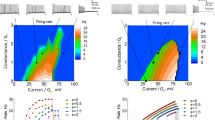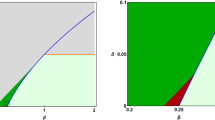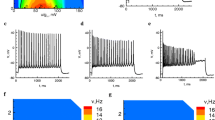Abstract
The precise mapping of how complex patterns of synaptic inputs are integrated into specific patterns of spiking output is an essential step in the characterization of the cellular basis of network dynamics and function. Relative to other principal neurons of the hippocampus, the electrophysiology of CA1 pyramidal cells has been extensively investigated. Yet, the precise input-output relationship is to date unknown even for this neuronal class. CA1 pyramidal neurons receive laminated excitatory inputs from three distinct pathways: recurrent CA1 collaterals on basal dendrites, CA3 Schaffer collaterals, mostly on oblique and proximal apical dendrites, and entorhinal perforant pathway on distal apical dendrites. We implemented detailed computer simulations of pyramidal cell electrophysiology based on three-dimensional anatomical reconstructions and compartmental models of available biophysical properties from the experimental literature. To investigate the effect of synaptic input on axosomatic firing, we stochastically distributed a realistic number of excitatory synapses in each of the three dendritic layers. We then recorded the spiking response to different stimulation patterns. For all dendritic layers, synchronous stimuli resulted in trains of spiking output and a linear relationship between input and output firing frequencies. In contrast, asynchronous stimuli evoked non-bursting spike patterns and the corresponding firing frequency input-output function was logarithmic. The regular/irregular nature of the input synaptic intervals was only reflected in the regularity of output inter-burst intervals in response to synchronous stimulation, and never affected firing frequency. Synaptic stimulations in the basal and proximal apical trees across individual neuronal morphologies yielded remarkably similar input-output relationships. Results were also robust with respect to the detailed distributions of dendritic and synaptic conductances within a plausible range constrained by experimental evidence. In contrast, the input-output relationship in response to distal apical stimuli showed dramatic differences from the other dendritic locations as well as among neurons, and was more sensible to the exact channel densities.
Similar content being viewed by others
References
Ascoli GA, ed (2002) Computational neuroanatomy: Principles and methods. Humana Press, Totowa, NJ.
Ascoli GA, Krichmar JL, Nasuto SJ, Senft SL (2001) Generation, description and storage of dendritic morphology data. Philos. Trans. R. Soc. Lond. B 356: 1131–1145.
Buzsaki G (2004) Large-scale recording of neuronal ensembles. Nat. Neurosci. 7: 446–451.
Davison AP, Morse TM, Migliore M, Shepherd GM, Hines ML (2004) Semi-automated population of an online database of neuronal models (ModelDB) with citation information, using PubMed for validation. Neuroinformatics 2: 327–332.
Golding NL, Kath WL, Spruston N (2001) Dichotomy of action-potential backpropagation in CA1 pyramidal neuron dendrites. J. Neurophysiol. 86: 2998–3010
Hines ML, Carnevale NT (2001) NEURON: A tool for neuroscientists. Neuroscientist 7: 123–135.
Hoffman DA, Magee JC, Colbert CM, Johnston D (1997) K+ channel regulation of signal propagation in dendrites of hippocampal pyramidal neurons. Nature 387: 869–875.
Ishizuka N, Cowan WM, Amaral DG (1995) A quantitative analysis of the dendritic organization of pyramidal cells in the rat hippocampus. J. Comp. Neurol. 362: 17–45.
Jarsky T, Roxin A, Kath WL, Spruston N (2005) Conditional dendritic spike propagation following distal synaptic activation of hippocampal CA1 pyramidal neurons. Nat. Neurosci. 8: 1667–1676.
Johnston D, Magee JC, Colbert CM, Cristie BR (1996) Active properties of neuronal dendrites. Annu. Rev. Neurosci. 19: 165–186.
Konig P, Engel AK, Singer W (1996) Integrator or coincidence detector? The role of the cortical neuron revisited. Trends Neurosci. 19: 130–137.
Larkum ME, Kaiser KM, Sakmann B (1999) Calcium electrogenesis in distal apical dendrites of layer 5 pyramidal cells at a critical frequency of back-propagating action potentials. Proc. Natl. Acad. Sci. USA 96: 14600–14604.
Lazarewicz MT, Migliore M, Ascoli GA (2002) A new bursting model of CA3 pyramidal cell physiology suggests multiple locations for spike initiation. Biosystems 67: 129–137.
Magee JC (2001) Voltage-gated ion channels in dendrites. In: G Stuart, N Spruston, M Hausser eds. Dendrites. Oxford University Press, pp 139–160.
Magee JC, Cook EP (2000) Somatic EPSP amplitude is independent of synapse location in hippocampal pyramidal neurons. Nat. Neurosci. 3: 895–903.
Magee JC, Johnston D (1995) Characterization of single voltage-gated Na+ and Ca2+ channels in apical dendrites of rat CA1 pyramidal neurons. J. Physiol. 487: 67–90
Mainen ZF, Sejnowski TJ (1996) Influence of dendritic structure on firing pattern in model neocortical neurons. Nature 382: 363–366.
Marder CP, Buonomano DV (2004) Timing and balance of inhibition enhance the effect of long-term potentiation on cell firing. J. Neurosci. 24: 8873–8884.
McDermott CM, Hardy MN, Bazan NG, Magee JC (2006) Sleep deprivation-induced alterations in excitatory synaptic transmission in the CA1 region of the rat hippocampus. J. Physiol. 570: 553–565.
Megias M, Emri Z, Freund TF, Gulyas AI (2001) Total number and distribution of inhibitory and excitatory synapses on hippocampal CA1 pyramidal cells. Neuroscience 102: 527–540.
Migliore M, Ferrante M, Ascoli GA (2005) Signal propagation in oblique dendrites of CA1 pyramidal cells. J. Neurophysiol. 94: 4145–4155.
Migliore M, Hoffman DA, Magee JC, Johnston D (1999) Role of an A-type K+ conductance in the back-propagation of action potentials in the dendrites of hippocampal pyramidal neurons. J. Comput. Neurosci. 7: 5–15.
Migliore M, Messineo L, Ferrante M (2004) Dendritic I h selectively blocks temporal summation of unsynchronized distal inputs in CA1 pyramidal neurons. J. Comput. Neurosci. 16: 5–13.
Migliore M, Shepherd GM (2002) Emerging rules for the distributions of active dendritic conductances. Nat. Rev. Neurosci. 3: 362–370.
Otmakhova NA, Otmakhov N, Lisman JE (2002) Pathway-specific properties of AMPA and NMDA-mediated transmission in CA1 hippocampal pyramidal cells. J. Neurosci. 22: 1199–1207.
Oviedo H, Reyes AD (2005) Variation of input-output properties along the somatodendritic axis of pyramidal neurons. J. Neurosci. 25: 4985–4995.
Pettit DL, Augustine GJ (2000) Distribution of functional glutamate and GABA receptors on hippocampal pyramidal cells and interneurons. J. Neurophysiol. 84: 28–38.
Poirazi P, Brannon T, Mel BW (2003) Arithmetic of subthreshold synaptic summation in a model CA1 pyramidal cell. Neuron 37: 977–987.
Poolos NP, Migliore M, Johnston D (2002) Pharmacological upregulation of h-channels reduces the excitability of pyramidal neuron dendrites. Nat. Neurosci. 5: 767–774.
Salinas E, Sejnowski TJ (2001) Correlated neuronal activity and the flow of neural information. Nat. Rev. Neurosci. 2: 539–550.
Scorcioni R, Lazarewicz MT, Ascoli GA (2004) Quantitative morphometry of hippocampal pyramidal cells: differences between anatomical classes and reconstructing laboratories. J. Comp. Neurol. 473: 177–193.
Shadlen MN, Newsome WT (1994) Noise, neural codes and cortical organization. Curr. Opin. Neurobiol. 4: 569–579.
Spruston N, Schiller Y, Stuart G, Sakmann B (1995) Activity-dependent action potential invasion and calcium influx into hippocampal CA1 dendrites. Science 268: 297–300.
Spruston N, Stuart G, Hausser M (2001) Dendritic integration. In: G Stuart, N Spruston, M Hausser eds. Dendrites. Oxford University Press, p. 231–270.
Stevens CF, Zador AM (1998) Input synchrony and the irregular firing of cortical neurons. Nat. Neurosci. 1: 210–217.
Vetter P, Roth A, Hausser M (2001) Propagation of action potentials in dendrites depends on dendritic morphology. J. Neurophysiol. 85: 926–937.
Watanabe S, Hoffman DA, Migliore M, Johnston D (2002) Dendritic K+ channels contribute to spike-timing dependent long-term potentiation in hippocampal pyramidal neurons. Proc. Natl. Acad. Sci. USA 99: 8366–8371.
Williams SR (2005) Encoding and decoding of dendritic excitation during active states in pyramidal neurons. J. Neurosci. 25: 5894–5902.
Wu WW, Chan CS, Disterhoft JF (2004) Slow afterhyperpolarization governs the development of NMDA receptor-dependent afterdepolarization in CA1 pyramidal neurons during synaptic stimulation. J. Neurophysiol. 92: 2346–2356.
Author information
Authors and Affiliations
Corresponding author
Additional information
Action Editor: Alain Destexhe
Rights and permissions
About this article
Cite this article
Li, X., Ascoli, G.A. Computational simulation of the input-output relationship in hippocampal pyramidal cells. J Comput Neurosci 21, 191–209 (2006). https://doi.org/10.1007/s10827-006-8797-z
Received:
Revised:
Accepted:
Published:
Issue Date:
DOI: https://doi.org/10.1007/s10827-006-8797-z




